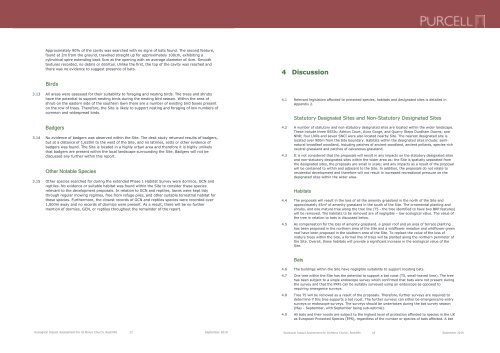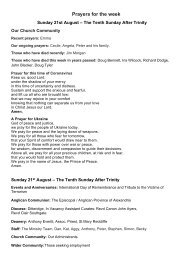St Mary Redcliffe Project 450 RIBA 2 Stage End Report
Create successful ePaper yourself
Turn your PDF publications into a flip-book with our unique Google optimized e-Paper software.
Approximately 90% of the cavity was searched with no signs of bats found. The second feature,<br />
found at 2m from the ground, travelled straight up for approximately 100cm, exhibiting a<br />
cylindrical spire extending back 5cm at the opening with an average diameter of 4cm. Smooth<br />
textures recorded, no debris or detritus. Unlike the first, the top of the cavity was reached and<br />
there was no evidence to suggest presence of bats.<br />
4 Discussion<br />
Birds<br />
3.13 All areas were assessed for their suitability to foraging and nesting birds. The trees and shrubs<br />
have the potential to support nesting birds during the nesting bird season. Within the area of<br />
shrub on the eastern side of the southern lawn there are a number of existing bird boxes present<br />
on the row of trees. Therefore, the Site is likely to support nesting and foraging of low numbers of<br />
common and widespread birds.<br />
Badgers<br />
3.14 No evidence of badgers was observed within the Site. The desk study returned results of badgers,<br />
but at a distance of 1,620m to the west of the Site, and no latrines, setts or other evidence of<br />
badgers was found. The Site is located in a highly urban area and therefore it is highly unlikely<br />
that badgers are present within the local landscape surrounding the Site. Badgers will not be<br />
discussed any further within this report.<br />
Other Notable Species<br />
3.15 Other species searched for during the extended Phase 1 Habitat Survey were dormice, GCN and<br />
reptiles. No evidence or suitable habitat was found within the Site to consider these species<br />
relevant to the development proposals. In relation to GCN and reptiles, lawns were kept tidy<br />
through regular mowing regimes, free from refuge piles, and other suitable terrestrial habitat for<br />
these species. Furthermore, the closest records of GCN and reptiles species were recorded over<br />
1,000m away and no records of dormice were present. As a result, there will be no further<br />
mention of dormice, GCN, or reptiles throughout the remainder of the report.<br />
4.1 Relevant legislation afforded to protected species, habitats and designated sites is detailed in<br />
Appendix 2.<br />
<strong>St</strong>atutory Designated Sites and Non-<strong>St</strong>atutory Designated Sites<br />
4.2 A number of statutory and non-statutory designated sites are located within the wider landscape.<br />
These include three SSSIs: Ashton Court, Avon Gorge, and Quarry <strong>St</strong>eps Durdham Downs; one<br />
NNR; four LNRs and seven SNCI were also located nearby Site. The nearest designated site is<br />
located over 900m from the Site boundary. Habitats within the designated sites include: seminatural<br />
broadleaf woodland, including patches of ancient woodland, ancient pollards, species-rich<br />
neutral grassland and patches of calcareous grassland.<br />
4.3 It is not considered that the proposals will result in any impacts on the statutory designated sites<br />
and non-statutory designated sites within the wider area as: the Site is spatially separated from<br />
the designated sites, the proposals are small in scale; and any impacts as a result of the proposal<br />
will be contained to within and adjacent to the Site. In addition, the proposals do not relate to<br />
residential development and therefore will not result in increased recreational pressure on the<br />
designated sites within the wider area.<br />
Habitats<br />
4.4 The proposals will result in the loss of all the amenity grassland in the north of the Site and<br />
approximately 45m 2 of amenity grassland in the south of the Site. The ornamental planting and<br />
shrubs, and one mature tree along the tree line (T5 - the tree identified to have two BRP features)<br />
will be removed. The habitats to be removed are of negligible – low ecological value. The value of<br />
the tree in relation to bats is discussed below.<br />
4.5 As compensation for the loss of amenity grassland, a green roof and an area of terrace planting<br />
has been proposed in the northern area of the Site and a wildflower meadow and wildflower green<br />
roof have been proposed in the southern area of the Site. To replace the value of the loss of<br />
mature trees within the Site, a formal line of trees will be planted along the northern perimeter of<br />
the Site. Overall, these habitats will provide a significant increase in the ecological value of the<br />
Site.<br />
Bats<br />
4.6 The buildings within the Site have negligible suitability to support roosting bats.<br />
4.7 One tree within the Site has the potential to support a bat roost (T5, small-leaved lime). The tree<br />
has been subject to a single endoscope survey which confirmed that bats were not present during<br />
the survey and that the PRFs can be suitably surveyed using an endoscope as opposed to<br />
requiring emergence surveys.<br />
4.8 Tree T5 will be removed as a result of the proposals. Therefore, further surveys are required to<br />
determine if this tree supports a bat roost. The further surveys can either be emergence/re-entry<br />
surveys or endoscope surveys. The surveys should be undertaken during the bat survey season<br />
(May - September, with September being sub-optimal).<br />
4.9 All bats and their roosts are subject to the highest level of protection afforded to species in the UK<br />
as European Protected Species (EPS), regardless of the number or species of bats affected. A bat<br />
Ecological Impact Assessment for <strong>St</strong>.<strong>Mary</strong>s Church, <strong>Redcliffe</strong> 17 September 2019<br />
Ecological Impact Assessment for <strong>St</strong>.<strong>Mary</strong>s Church, <strong>Redcliffe</strong> 18 September 2019


















